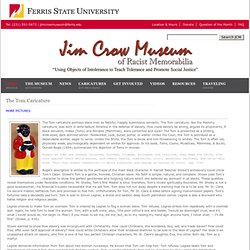

Uncle Tom's Cabin In-Depth - Harriet Beecher Stowe. *Kentucky *Kentucky.

South-central U.S. state that provides the setting for the first third of the novel. Kentucky is an appropriate location for slaves hoping to escape because it is separated from free territory only by the Ohio River. Harriet Beecher Stowe also felt comfortable describing this area since she spent a number of years living in nearby Cincinnati, Ohio. Shelby farm Shelby farm. The narrative returns periodically to the Shelby farm to follow the fate of the Shelby family and of Tom’s wife, Aunt Chloe. Uncle Tom’s cabin Uncle Tom’s cabin. *Ohio River *Ohio River. *Ohio *Ohio. Words and actions are also one at the Quaker settlement, a model of perfect domesticity, both in its actual physical arrangement as well as its moral order.
*Mississippi River *Mississippi River. Uncle Tom's Cabin & American Culture. Uncle Tom Mania: Slavery, Minstrelsy, and Transatlantic Culture in the 1850s - Sarah Meer. Uncle Tom's Cabin and the Reading Revolution: Race, Literacy, Childhood, and ... - Barbara Hochman. Whitewashing Uncle Tom’s Cabin.
Nineteenth-Century Women Novelists Respond to Stowe Joy Jordan-Lake Publication Year: 2005 Few books have had greater impact on U.S. history than Harriet Beecher Stowe’s Uncle Tom’s Cabin.

The first American novel to sell more than a million copies, it provoked an entire reading public to extol it, debate it, weep over it, excoriate it. Fighting fire with fire, slavery apologists from North and South responded with their own fiction, producing over three dozen novels in direct response to Stowe’s work. Few books have had greater impact on U.S. history than Harriet Beecher Stowe’s Uncle Tom’s Cabin. E-ISBN-13: 9780826591890 Print-ISBN-13: 9780826514752 Print-ISBN-10: 0826514758 Page Count: 232 Publication Year: 2005. Schlüssel zu Onkel Tom's Hütte / Stowe, Harriet Beecher.
Society for Applied Anthropology - Log In - Resource Secured. Tom Caricature. The Tom caricature portrays black men as faithful, happily submissive servants.

The Tom caricature, like the Mammy caricature, was born in ante-bellum America in the defense of slavery. How could slavery be wrong, argued its proponents, if black servants, males (Toms) and females (Mammies), were contented and loyal? The Tom is presented as a smiling, wide-eyed, dark skinned server: fieldworker, cook, butler, porter, or waiter.
Unlike the Coon, the Tom is portrayed as a dependable worker, eager to serve. Unlike the Brute, the Tom is docile and non-threatening to whites. Bogle's description is similar to the portrayal of the main black character in Harriet Beecher Stowe's antislavery novel Uncle Tom's Cabin. Legree intends to make Tom an overseer. Stowe wanted to show how slavery was incongruent with Christianity. Legree demands information from Tom about two women runaways. Legree beats Tom; Sambo, one of Legree's black overseers, flogs Tom. Cinematic Uncle Toms Commercial Toms. Uncle Tom’s Cabin: Chapters XIV–XVI. Summary: Chapter XIV Tom and the other slaves continue to travel down the Mississippi River, joined by travelers and workers headed for New Orleans.

Tom has won Haley’s confidence with his meek obedience. Therefore, he has received permission to roam the boat freely. He sits up in a nook in the cotton bales, reading his Bible. While there, Tom meets a little girl named Eva St. One day, Eva falls over the side of the boat, and, while everyone else stands by in shock, Tom plunges over the side of the boat and saves her. Summary: Chapter XV Here we learn the background of the St. We also learn something about St. Next the reader learns that, to help him take care of his child and his difficult wife, St. St. Summary: Chapter XVI. The Tom Caricature.